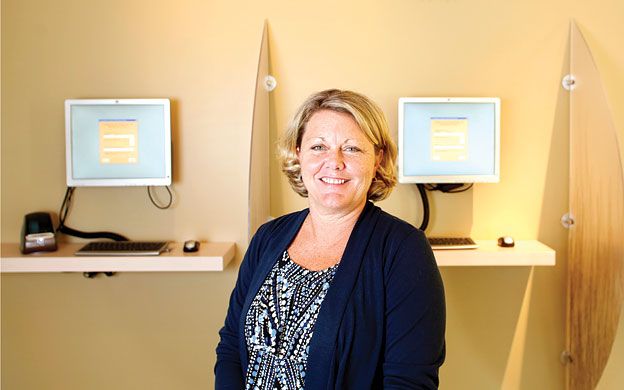Coastal Women's Healthcare pioneers electronic records
At Coastal Women's Healthcare, an expectant mother bypasses two receptionists near the practice's front door on her way to a kiosk where she prints labels for her own lab work, gets directions to her exam room and digitally notifies the medical staff that she has arrived.
After a quick detour to the restroom, she leaves a properly labeled urine sample in the lab as she settles into the exam room. When her exam is over, she will stop at another kiosk to pay her bill, or scan her insurance card, and make an appointment for her next visit.
All told, her time at the kiosk is just a few minutes compared with the half-hour or more the check-in and check-out routine took before Coastal Women's Healthcare invested $750,000 in an electronic records system widely regarded as a pioneering model in the medical services industry. The system, now in its fourth year, has decreased costs and increased efficiency and accuracy and — perhaps most importantly — patient safety. An added bonus: the time women once spent interacting with administrative staff is now spent with clinical staff.
"We believe that our use of technology will allow us to be prepared to take care of a higher volume of patients in a safe, efficient manner," says Dr. Erin Dawson-Chalat, one of the eight Coastal practitioners who own the Scarborough-based practice. "We are sure our practice would not be sustainable without the use of our [electronic medical records] and connectivity to other care providers in the community."
The practice was recognized by the federal Centers for Medicare and Medicaid Services for its transition to electronic health records, and for meeting "meaningful use" standards, objectives designed to ensure that providers use their technology in significant ways to improve safety and patient care, such as quantifying the percentage of women 40 to 69 years of age who had mammograms, or were screened for cervical cancer. Dr. Barbara Slager, president of the practice and the main architect of the record system, accepted the Meaningful Use Vanguard award in Health Information Technology from the agency in May.
In March, the practice was the first independent women's health care practice to connect to HealthInfoNet, the statewide health information exchange. The exchange combines medical records from separate health care providers into one electronic file that can be securely shared within the medical community.
A preponderance of paper
The practice started its journey toward electronics in 2008 when it confronted a "very outdated" paper filing system, says Executive Director Beverly Neugebauer. The practice was formed in 1995 through the merger of Gynecology Associates of Western Avenue in South Portland and Coastal OB GYN of Portland.
Owned by eight obstetrician/gynecologists, the practice decided to adopt an electronic filing system to streamline and corral data and to improve patient safety.
Nurses — because of their clinical expertise — inserted data from 30,000 patient charts into the new system after data fields were determined by the medical staff. The data fields give the medical staff the ability to search or update fields for each patient, says Neugebauer.
Three years of health records were entered, plus previous pertinent results such as positive mammograms or other tests, Neugebauer says. Then, about 20,000 charts — paper records of normal tests and records of routine visits — were filed offsite.
The staff began implementing the system over three months, moving forward in stages, first using electronic records with annual visits. When those were mastered, they moved on to "problem visits," and finally adopted electronic records for deliveries, Neugebauer says.
"Once you [switch to electronic records], it does take on a life of its own," she says.
The transition was dramatic for staff, and although physicians communicated the pending changes, some employees opted to leave the practice rather than learn the new system.
The result for the practice, however, has been that "we have the same number of [employees] but are just doing more for the patients," says Neugebauer. "We have less administrative staff and more clinical staff, and can focus more on taking care of the patient and not on pulling your chart."
Today, 11 practitioners — including two nurse practitioners and one certified nurse midwife — deliver about 600 babies each year at Maine Medical Center. The practice counts 20,000 active patients — adding 1,500 to its roster each year — and schedules about 30,000 appointments annually.
CWHC generates $8 million in revenue, including revenue from digital mammography and ultrasound services, a lab, ultrasound (digital) and bone density testing.
"We try to take care of the whole woman," Neugebauer says.
Fine tuning
Slager, whom Neugebauer describes as the "champion" of the electronics initiative, designed a template for a one-page "Facesheet," which contains information on each patient including, for example, her current concern, the date of her last annual exam, recent mammogram and bone density tests, and whether allergies and medications were reviewed during the visit.
The Facesheet includes an image of the human body so practitioners can mark the location of pain, or suspicious moles, or anything else site-specific on a patient's body. Previous diagnoses, medications and other information about the patient are searchable from the Facesheet.
"If I am a provider, everything pertinent about this patient should be on this page, so I don't have to delve in [to more files]," Neugebauer says. "So we trained all our clinical staff to take very good care to populate [these pages]."
The collaboration with HealthInfoNet means the records at CWHC are "pushed out" to other networks in the system — including MaineHealth and Martin's Point — to create what Neugebauer calls "a community health record."
That collaboration decreases duplication of effort and saves money, she says.
"In the past, if the docs were concerned enough about symptoms, sometimes they would have no choice but to repeat a test [done previously at another facility]," she says. "That's where the efficiency piece comes in. We should not have to repeat tests. If your community health record is complete, it will be in there."
Soon, HealthInfoNet will include an image library, and Neugebauer says CWHC will share its images as well as the records.
Enhanced confidentiality
Dawson-Chalat says the electronic record system allows physicians at CWHC to coordinate care with other specialists, and the advanced technology allows them to provide their patients with "the most thorough, complete care possible."
"Using technology for the transmission and handling of patient records reduces the instance of error and increases confidentiality," says Dawson-Chalat. "When handling a paper chart, sometimes five people would handle and view a result before it got to the record and the provider. Results are now returned with certain accuracy having been seen by only the provider."
Within one year, Neugebauer says, the $750,000 investment paid for itself through decreased expenses and increased revenue — the latter because the practice can now collect insurance payments 30 to 60 days faster than it could previously, she says.
Revenue was increased through proper documentation and more accurate recording of services provided, Neugebauer says. "Our expenses dropped drastically when we no longer required printed forms, heavy-duty charts and paper," she says. "In addition, our staffing levels decreased as roles changed. Today, we have increased our clinical staff to care for our patients and decreased our administrative staff by 10 (full-time employees)."
Early this year, Coastal Women's Healthcare received $110,000 in incentive payments from the Department of Health and Human Services, through a program to help practices transition to electronic medical records. Over five years, CWHC expects to receive a total of $200,000 in incentive payments — offsetting by nearly a third the initial investment of $750,000.
But Neugebauer says the more important benefit has been in patient safety.
"By 'safety' I mean the accuracy of your records getting to a doctor in a timely manner," she says. "Information coming directly from you into your chart is safer than you telling someone who interprets it and enters it into the chart."
She offers an example of a routine lab test. Once the test is ordered by a doctor, the order is sent electronically to the lab, the test is run and the results are returned electronically to the doctor's digital inbox "without a person touching them," Neugebauer says. "Nobody saw [the results] and there's no potential for it to be scanned to the wrong chart [or] left on a fax machine, so that's the safety piece that we really did not even begin to see until we were all electronic."
Although some patients initially questioned the security of their data, Neugebauer says the potential for error is reduced under the new system due to strict regulations.
"We say [the system] is twice as secure as bank data because on both ends there are firewalls," she says, referring to the practice's affiliates such as a lab or a pharmacy.
Since the system went online, there have not been any breaches, says Neugebauer. Annual security checks are conducted by outside vendors.
Since CWHC transitioned to electronic records, close to a dozen other Portland-area practices have followed suit, Neugebauer says. That puts Maine in the vanguard of health information exchanges in the country, says Gemma Cannon, regional extension center service coordinator at HealthInfoNet. "We're probably five years ahead of the rest of the country because the health care community in Maine has been so forward-thinking," she says.
The physicians at Coastal Women's Healthcare, she says, "really are very forward-thinking. They are aware of the technology as it can help the patient. They really are a very vanguard practice."
According to Cannon, CWHC saved itself even more money given looming Medicaid and Medicare penalties for practices that don't meet federal meaningful use standards starting in 2015.
"They did it because they had to make a decision to support their independence with the best tools possible, and they went out and did it," Cannon says. "They're really pioneers."
Writer Beth Brogan can be reached at editorial@mainebiz.biz.












Comments